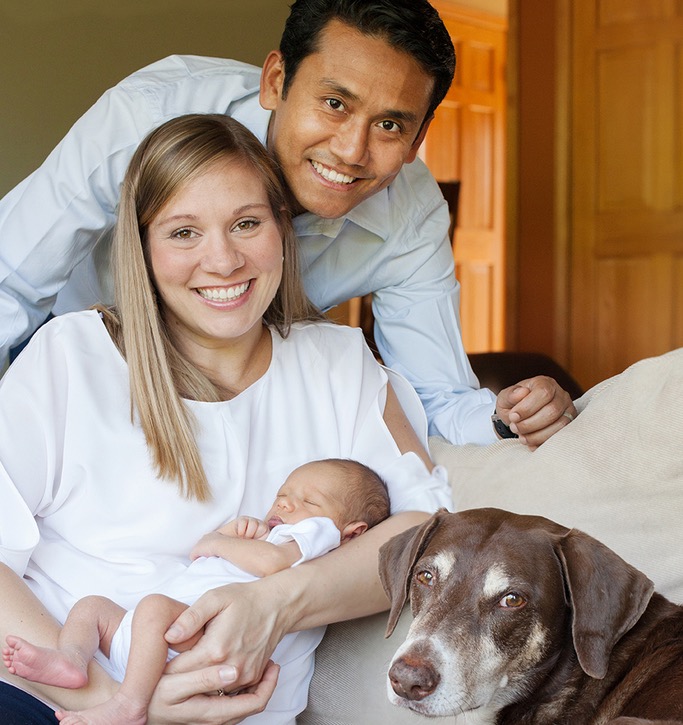We talked to two families to see how different life for working parents is in this Scandinavian Country versus the U.S.

Jessica Zoladz is a senior medical science liaison for a genetic testing company in upstate New York. Four months ago, she gave birth to a baby boy, and since her 12 weeks of maternity leave ended, she’s been forced into using her breast pump in airports, airplanes, hotel rooms, and brake-jerking taxicabs.
She was lucky—unlike a lot of American employees, she had eight weeks of paid leave through her employer. The other four weeks were unpaid under the Family Medical Leave Act of 1993 (FMLA), which guarantees 12 weeks of family leave without any compensation to workers of private-sector employers with 50 or more employees.
While Jessica works from home, her job also requires that she travel to different parts of the country on a regular basis to make presentations to physicians. Her husband, Zarni, a native of Myanmar, also holds a professional position as a network administrator for a local petroleum distributor. His company did not offer paternity leave, so he took only four days of unpaid leave postpartum.
Their son is currently attending day care two days per week. The other three weekdays are covered by Jessica’s 72-year-old mother. Jessica and Zarni earn an above-average joint income, but to take on five days per week of day care costs would have “significantly impacted our finances.” Jessica says. “The costs are extremely high, and we are lucky that my mother is able to help.”
From our partners:
MEET THE RUOHONENS FROM FINLAND

Contrast Jessica and Zarni to Kaisa and Tapani Ruohonen from Tampere, Finland, who have two daughters, age two and five. Kaisa and Tapani are both working professional engineers for manufacturing companies. They too earn above-average incomes by Finnish standards.
Kaisa received 18 months of paid maternity leave (nine for each daughter) at about 70% of her salary. Tapani took 18 weeks (nine each) of a similarly paid paternity leave. Tapani also took advantage of an additional 11 months of leave when Kaisa went back to work—three with the first child and eight with the second child—taking a lesser-paid “parental allowance” under the Finnish government’s social welfare system—a subsidy that was equal to about 400 euros per month, taxable—or about $450 at the current exchange rate.
The parental leave was provided through Kela (Kansaneläkelaitos in Finnish), Finland’s government-sponsored social insurance institution. In addition to maternity, paternity, and parental allowances, all new Finnish parents are entitled to receive a “maternity package” when their child is born. The package includes clothes, bedding, pajamas, towels, and various other child-care products, all in a cardboard box that converts into a small crib if necessary. Parents can also opt into receiving the equivalent of about $155 instead of the package.
According to Kela representative Pauliina Venäläinen, the average total amount of paternity leave benefits accumulated by new Finnish dads is 33 days and 2,800 euros ($3,143). For maternity leave, new Finnish moms took an average of 257 days and 15,300 euros ($17,176).
Additionally, Kela pays a tax-free, monthly “child benefit” for each child up to age 17. The benefit starts at 95 euros ($106) per month for a first child and goes up gradually for each additional child. For a third child, for instance, the benefit is another 135 euros ($151) per month.
“It does not matter if you have 17 kids, you can always have nine months of maternity leave,” Tapani says. Plus, such relatively long family leaves do not bring about any change in job status. “Kaisa was promoted just before she went on her second maternity leave, and that did not have any effect on her work. She went back to work in the same promoted spot she had. It is written in Finnish law that becoming pregnant should not have any kind of effect on your career.”
FINDING DAY CARE IN NEW YORK

Jessica and Zarni did some serious searching to find the right facility for those two days of early-childhood care they needed. Because she and Zarni are new to the area, having recently relocated from Chicago to be closer to her parents, they did not have any referral-based resources to help with their decision-making. “I just basically did a Google search for facilities that were near my house,” she explains. “I went and visited them. Some were really professional and impressive. Others were intimidating to go into. You could see all these kids and very few adults.”
She found an early-childcare center that she could easily drive to that met her standards. For the two full days of day care they selected, Jessica and Zarni pay a little more than $500 per month. “I am pleased with our day care, but I also feel it would be easier on my son if he was older,” Jessica says.
The average monthly cost for full-time day care for an infant in New York State, according to 2012 figures from the Pew Research Center, is about $1,245 per month.
FINNISH DAY CARE CENTERS
When both Kaisa and Tapani completed their terms of leave and returned to work, they enrolled their girls on a five-day-per-week basis in a local Tempere day care center. They had no trouble finding a competently and adequately staffed facility, as these so-called “municipal day care centers” are located throughout the city. The center they are currently utilizing is conveniently located within walking distance of their home.
Ruohonen’s cost for day care covering five days each week for both children is a discounted 583 euros monthly (or about $600). They are allotted the maximum a family can pay for day care, based on their income. Some families in Finland who have lower incomes are not charged anything. “Our kids enjoy it,” Tapani says. “It is in a very modern building and everything is new.”
According to Tarja Kahiluoto, special government adviser to the Finnish Ministry of Education, Science and Culture, some of the strengths of Finland’s officially named Early Childhood Education and Care (ECEC) include a system that guarantees access to day care as a universal right, maintains affordability, honors the integration of children with special needs, adheres to national curriculum guidelines, and orders that these centers have a well-educated staff. There is also a freedom of choice mandate, where allowances are provided to parents who choose home care or private care as opposed to the utilization of municipal centers.
EARLY-CHILDHOOD EDUCATION PROVIDER QUALIFICATIONS
There are dissimilarities between what the Finns require of their early-childhood providers and what’s required in the U.S. Kahiluoto explained that one in three of any day care center staff must have a college degree, either a bachelor’s or master’s in education or social science. The remaining staff must have a minimum of an upper-secondary qualification in the field of social welfare and health care, or what would be similar to a community college certificate or associate’s degree in the U.S.
The lead teachers in Finnish day care facilities have gone through a highly challenging and competitive process and curriculum to earn their higher education degrees. One in 10 applicants are accepted into Finnish college teacher-preparation programs, according to the National Center on Education and the Economy, adding that “only candidates with a clear aptitude for teaching in addition to strong academic performance are admitted.”
In a March 2014 NPR broadcast, Finland’s minister of education explained how having “high-quality teachers” at such an early age is a vital part of Finnish society that Finns take great pride in. “We trust our teachers, and that’s very, very important,” she says. “If you invest in early childhood education, in preschool and day care, that will lead to better results.”
In the U.S., the federal government has laws that ensure proper health and safety at day care centers, but the parameters regarding educational attainment required by day care employees varies by state, and many states pale in comparison to Finland. According to the Bureau of Labor Statistics Occupational Outlook Handbook, many states require assistant day care workers to only have a high school diploma, For directors and teachers of day care centers, a college degree may be necessary, but it’s definitely not mandatory across the country.
Teachers of children under the age of two in the state of New York, for instance, must be at least 19 with either an associate’s degree in Early Childhood Education or a Child Development Associate certificate, along with a study plan leading to an associate’s degree. A teacher will also qualify if she has a GED and nine credits in Early Childhood Education, plus a study plan leading to an associate’s degree and one year of experience working with infants or toddlers, as noted by the Day Care Council of New York.
THE BOTTOM LINE
It’s easy to see how the Finnish system of providing nine months of paid maternity leave and nine weeks of paid paternity leave, along with having easy access to affordable and professional day care services, creates a lot less stress for new parents. There is a trade-off, however, as the Ruohonen’s joint income is taxed somewhere near 30%—about 10% more than what Jessica and Zarni pay in joint income taxes.
The Ruohonens also incur less expenses overall, as they live in a three-bedroom townhouse that is half the size and roughly half the mortgage of the large suburban home that Jessica and Zarni recently purchased. Their health insurance is tax subsidized; and, like all Nordic countries, so is college tuition, as well as their retirement. In effect, all the safety nets for not going broke or incurring huge amounts of debt are intact.
CHANGE HAPPENING NOW AND ON THE HORIZON
Of course, the challenges and concerns of a new mom like Jessica are commonplace throughout the U.S., where the only rule of law for family leave is the drastically lacking unpaid FMLA.
The recent announcements by Netflix and other major firms following suit by offering their employees more generous family leave are just starting to scratch the surface when considering the vast majority of U.S. companies that do not even have “paid” maternity or paternity leave benefits. But things look to be getting somewhat better, albeit slowly.
Adobe Systems Incorporated, based in San Jose, California, is a positive case in point. The company recently upped its employee financial benefits significantly for its 6,000 employees in the U.S., about 2,000 of whom are women, by increasing maternity leave from nine weeks to 26 weeks at 100% base salary. The increase takes effect on November 1, 2015.
Donna Morris, Adobe’s senior vice president, global people and places, says, “It’s pretty sad to hear stories of the average American working somewhere who has a child and is back to work in six weeks after giving birth. As a mom myself, it would be pretty hard to rebound after six weeks and be back at work. What we want to do is support our employees so that they are really able to be at their very best, and I think it is hard to be at your very best in the event that you just brought a new baby home.”
Morris adds, “While other countries might have more of a social safety net, in our country at this point and time they (similar government-sponsored or mandated social safety nets) do not exist. I think what it means is those employers in sectors that are highly competitive will want to continue to differentiate and provide the rewards that will allow you to attract and keep the very best talent.”
Getting some help with day care, however, is another story that has a long way to go to catch up to places like Finland. It’s an extremely important financial and scheduling concern for working parents in the U.S. that shows no signs of getting any easier.
This feature originally appeared in Fast Company.


















